CIA tactics: What is 'enhanced interrogation'?
- Published
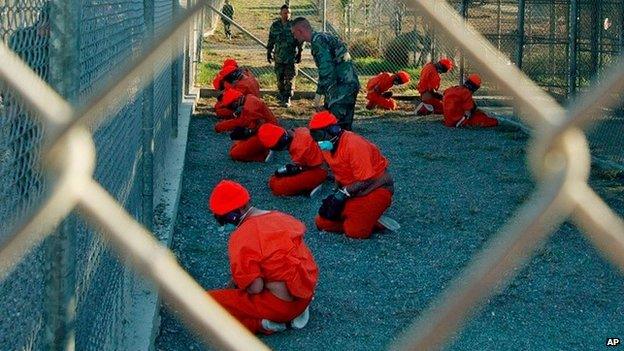
Detainees at the US prison camp in Guantanamo Bay in January 2002
Details of harsh interrogation techniques used by the CIA on suspected terrorists have been made public by the US Senate Intelligence Committee.
Former US President George W Bush said the CIA had saved lives by using "enhanced interrogation techniques" to acquire information from suspects but insisted: "This government does not torture people."
President Barack Obama, however, condemned the CIA interrogation programme as a "dark and painful chapter" in US history and signed an executive order banning the techniques on his second day in office.

What are 'enhanced interrogation techniques'?
Shortly after the attacks on 11 September 2001, the CIA drew up a list of new interrogation techniques that included sleep deprivation, slapping, subjection to cold and simulated drowning, known as "waterboarding".

Khalid Sheikh Mohammed, planner of the 9/11 attacks, is said to have been waterboarded 183 times
Waterboarding involves a prisoner being restrained on his back with their feet at a level higher than their head, or tied upside down. A cloth is placed over the prisoner's face or pushed into their mouth. Sometimes plastic film is used.
Water is then poured on to their face and into their nose and mouth. The prisoner gags almost immediately as the water starts entering the lungs.
As they start to feel they are drowning, they typically panic and struggle, and their body goes into spasm. Waterboarding can result in brain damage, broken bones and psychological damage.
The report also details an "aggressive phase of interrogation" for detainee Abu Zubaydah where he was confined to a coffin-sized box for a total of 266 hours. He was kept in an even smaller box for 29 hours.
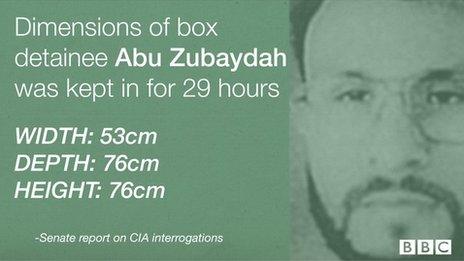
It also describes the use of sleep deprivation for up to 180 hours, painful stress positions, sexual threats and humiliation.
The controversial methods were used by CIA interrogators at secret locations across the world, known as "black sites".
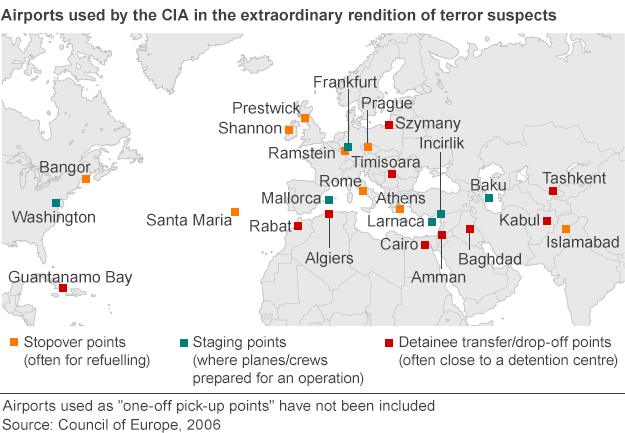

Do the techniques constitute torture?
Torture is defined by the UN Convention against Torture, external, which the US has signed, as "any act by which severe pain or suffering, whether physical or mental, is intentionally inflicted on a person" in order to get information.
The US legal code, external defines torture as an action "specifically intended to inflict severe physical or mental pain or suffering", while the US Constitution bans "cruel and unusual punishment".
Human rights groups and several foreign governments say the CIA programme included torture.
But the US government under Mr Bush did not agree and made a distinction between "torture", which it accepted is banned by US and international law, and "enhanced interrogation techniques".
However, President Barack Obama halted the programme when he took office in 2009, and acknowledged that many of the measures amounted to torture, external. "I believe that waterboarding was torture and, whatever legal rationales were used, it was a mistake," he told reporters.

What was the justification?
In April 2009, President Obama released a series of legal memos, external written between 2002 and 2005 by lawyers under the Bush administration that sought to justify the use of waterboarding and other methods.
The memos argued that the methods were not "cruel, inhuman or degrading" under international law and highlighted safeguards, such as conducting the interrogations under the supervision of a physician or psychologist with the authority to stop it.
One memo said waterboarding would only be used when the CIA had "credible intelligence" that a terrorist attack was imminent and there were "credible indicators" that the subject possessed "actionable intelligence".
Former CIA lawyer John Rizzo authorised the programme. Speaking to BBC Newsnight earlier this year, Mr Rizzo said capturing and interrogating terrorists was better than killing people through drone strikes.
Former CIA lawyer John Rizzo on 'enhanced interrogation': "I don't think I had any other choice."

Were the techniques effective?
The CIA used "enhanced interrogation techniques" for several years but it is unclear how many detainees were subjected to the methods. Only three people are believed to have been subjected to waterboarding.
According to ex-CIA officer John Kiriakou, al-Qaeda suspect Abu Zubaydah "broke" within half a minute of being waterboarded. Abu Zubaydah said later he had made things up to satisfy his interrogators.
A justice department memo reported by the New York Times in 2009, external revealed that CIA interrogators had used the waterboarding technique 83 times on Abu Zubaydah and 183 times on Khalid Sheikh Mohammed, who planned the 9/11 attacks.
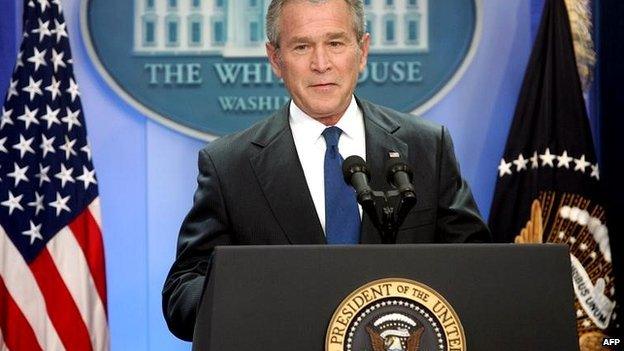
George W Bush said waterboarding helped stop attacks on Heathrow Airport and Canary Wharf in London
The third person known to have been waterboarded is Abd al-Rahim al-Nashiri, the alleged mastermind of the 2000 attack on the USS Cole, external.
The practices were brutal and produced little intelligence of value, a leaked White House memo said in July 2014, external.
The arguments over waterboarding reflect all arguments about similar methods. Do they produce information or lies? Can the information be obtained by other means? And are they counter-productive?
The Senate committee concluded that the CIA's use of "enhanced interrogation techniques" was not an effective means of acquiring intelligence or gaining co-operation from detainees.
It also criticised the CIA for allowing two psychologists, who had no background in counter-terrorism and who were hired to develop procedures, to assess the effectiveness of their own programme.

Will anyone be prosecuted for torture?
The UN and human rights groups have called for the prosecution of US officials involved in the use of "enhanced interrogation techniques".
Ben Emmerson, UN Special Rapporteur on Human Rights and Counter-Terrorism, said in a statement: , external"As a matter of international law, the US is legally obliged to bring those responsible to justice."
Critics of the programme have called for George W Bush himself to be investigated, alongside former Vice-President Dick Cheney, former Defence Secretary Donald Rumsfeld and ex-CIA Director George Tenet.
However, President Obama has previously stated: "Those who carried out their duties relying in good faith upon legal advice from the department of justice... will not be subject to prosecution."
There have been previous investigations but they have not resulted in any prosecutions.
In 2012, US Attorney General Eric Holder looked into CIA interrogation practices overseas but said the evidence was not "sufficient to obtain and sustain a conviction beyond a reasonable doubt".

CIA interrogations: Post-9/11 timeline
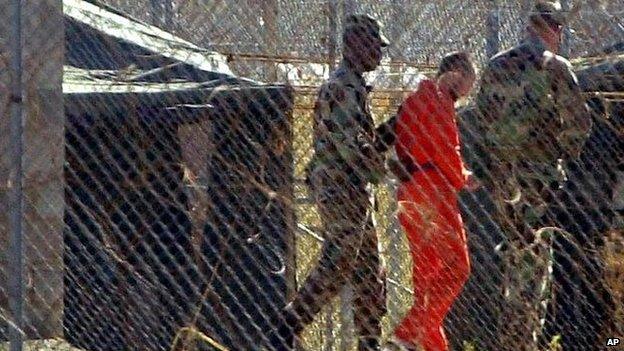
17 September 2001: President Bush authorises CIA to detain suspected terrorists
August 2002: Abu Zubaydah, a Saudi terror suspect, subjected to persistent "coercive interrogation", including waterboarding
November 2002: Abd al-Rahim al-Nashiri transferred to CIA custody and subjected to waterboarding.
March 2003: Khalid Sheikh Mohammed, suspected 9/11 mastermind, captured - later waterboarded 183 times
2 November 2005: Washington Post reveals existence of global CIA interrogation programme
8-9 November 2005: CIA authorises destruction of "coercive interrogation" videotapes
September 2006: President Bush publicly acknowledges the programme for the first time
March 2008: President Bush vetoes legislation to limit CIA interrogation techniques.
January 2009: President Barack Obama bans the CIA's detention authority and limits interrogation to techniques authorised by the Army Field Manual.
- Published8 December 2014

- Published10 January 2014

- Published31 July 2014
